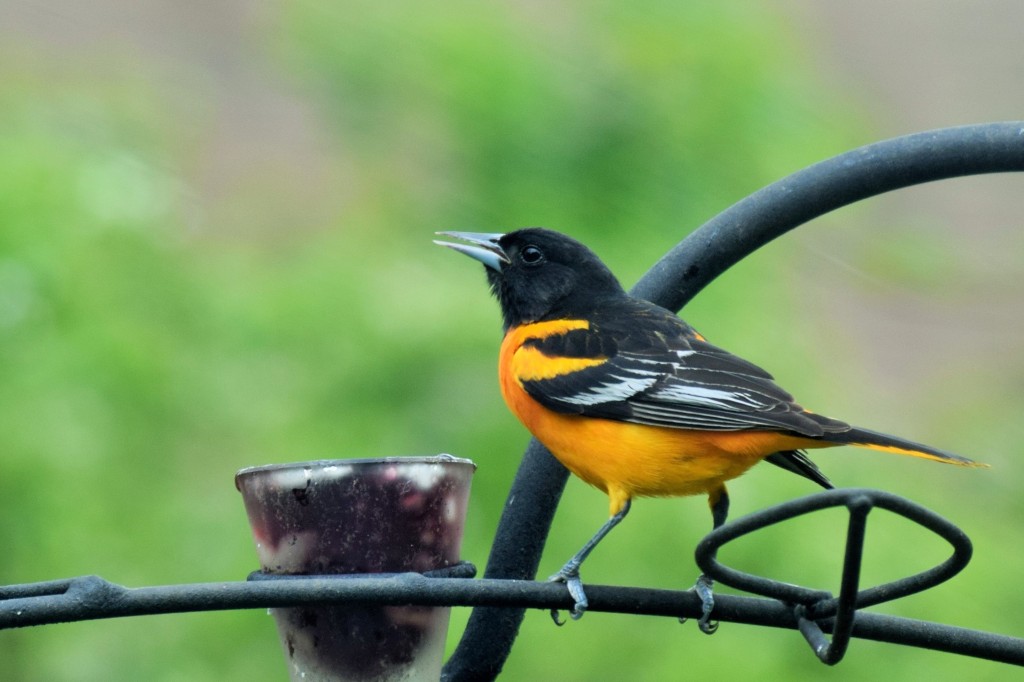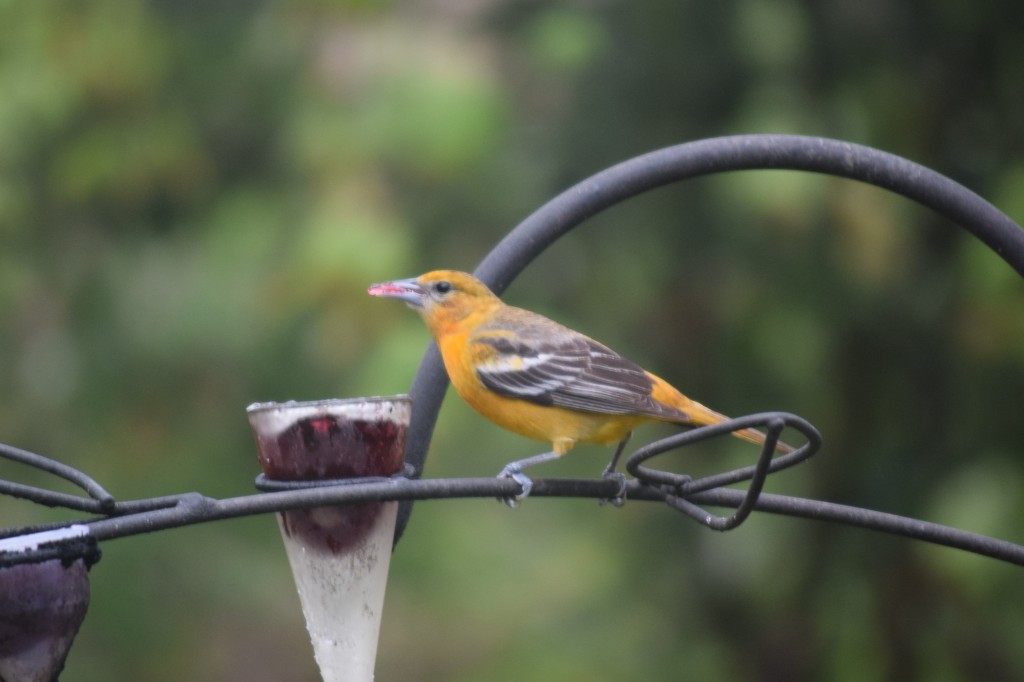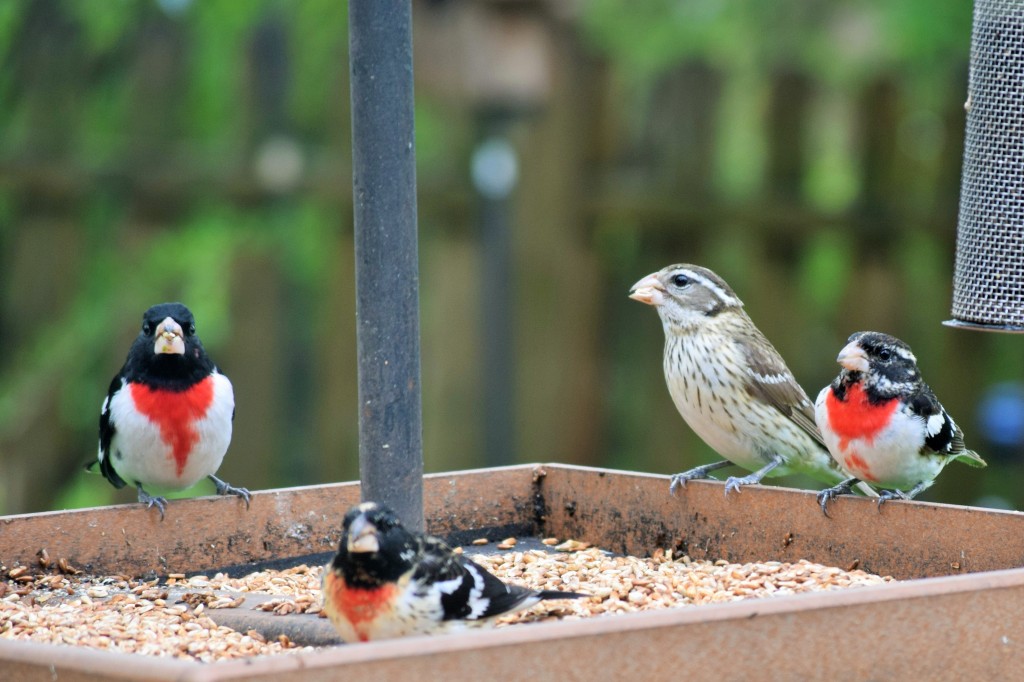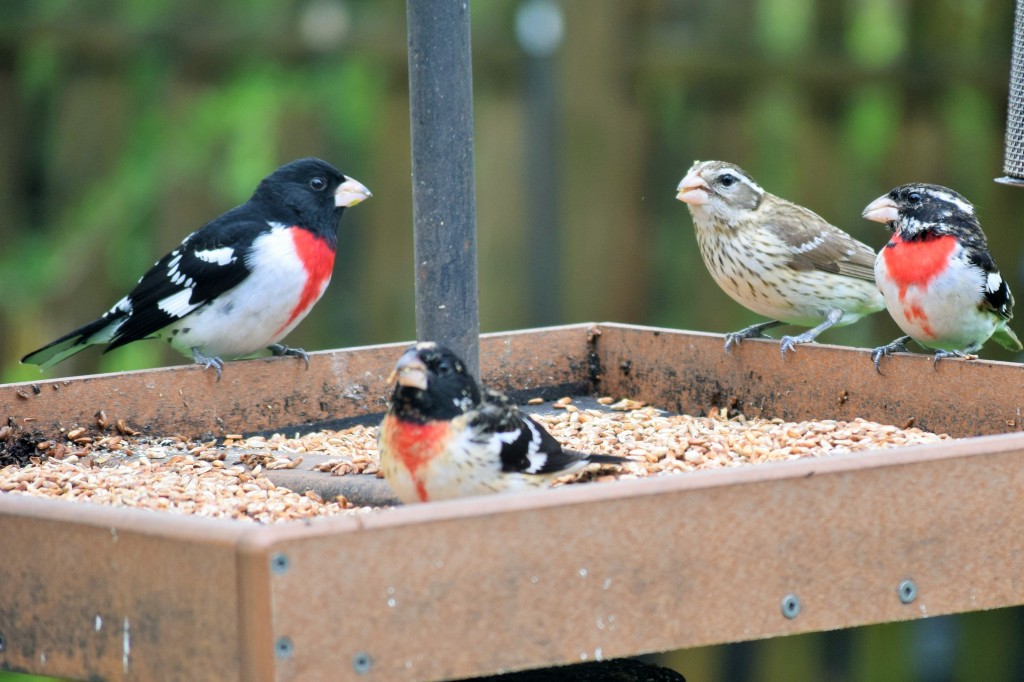Return of the Prodigal Songbirds
Right around May 1 they return from winters spent in southern Mexico, Central America, and the Caribbean. (If only I could spend my winters there.)

Of all the migrating birds that return from the tropics, my favorites are probably the Baltimore Orioles and Rose Breasted Grosbeaks.

In late April I start putting out grape jelly and oranges for the Orioles, safflower seeds for the Grosbeaks.
I maintained an anxious watch on the feeders, but by May 4th there had been no appearances. Then I had to go out of town. The morning after I returned, however, there they were: the Orioles with their striking plumage of black and bright orange, the Grosbeaks wearing red chevrons on their chests (suitable, I always thought, for superheroes).

Once they arrive, the Baltimore Orioles will visit the feeders all summer. Their normal diet consists of fruit and insects, and they prefer to spend most of their times up in the treetops.

Jelly and colorful ripe fruit (oranges, but also cherries and grapes) will tempt them into making appearances at lower elevations, however.
The song of Baltimore Orioles has a certain fullness to it, but they chatter sometimes as well. Here’s a link to what they sound like.

Rose Breasted Grosbeaks visit feeders for only a few weeks in May. They like sunflower, safflower, and peanuts – though I notice at our feeder that they have also developed a taste for jelly.
The males look like they are wearing dark suits and starched white shirts with a bright red tie.
They are woodland birds whose song sounds a bit like American Robins. Here’s a link.
Have migrating birds been arriving in your garden?






I think we really only have swallows, swifts and house martins that migrate here. The swallows are the ones I love to see come back (around very beginning of April). Someone recently did a fabulous renovation job on one of the old ‘hotels’ in the village here (which had a tower). It’s wonderful, but I think perhaps we have fewer swallows in the garden now as a result of having the new improved tower!
There’s a whole collection of swallow houses at the Chicago Botanic Garden. I am for helping out any bird that eats mosquitos.
I saw a single Rose Breasted Grosbeak about 2 weeks ago at the safflower feeder. It was very shy and would fly away if it could see me through the kitchen window, so I had to be very sneaky.
I would say our Grosbeaks are about average for shyness. But sneakiness is important for getting those bird pictures.
Thank you for your article about the Oriole and Grosbeak. We were treated last month with a visit from Indigo Buntings and Rose Breasted Grosbeaks–the first I’ve seen in my suburban Atlanta garden. They ate the black oil sunflower seed–I wonder if I had fed them their favorites, the visit might have been longer. I really enjoy your blog.
We just say an indigo bunting yesterday – what amazing color!
Fun to see your pretty birds…so different from the ones that visit us.
Aren’t there Orioles on the PNW?
Very dapper! Love the mental picture of superhero grosbeaks (Marvel(ous) X-Birds?? 😉 ).
How many feeders do you have, Kathy? Your avian restaurant attracts so many customers!
Marvel(ous) X-Birds! Think of the merchandising possibilities! We have two feeding poles, plus bird baths.
Welcome visitors back each spring! We’ve had more grosbeaks than orioles this year than in the past, for some reason. The patterns of migration are fascinating.
This year the Grosbeaks are landing on the feeder in groups of about six, so I’d say there are more of them here as well. Orioles I think are about the same.
I wondered where those little buggers got to! They were just in my back yard a week ago! travel fast!
Apparently, they do!
Help, my roses have been hit with everything. I tried Bayer for roses and now I am using Seven, both were sprays. Loretta
Ah, I am not much of a rose person, so I would be reluctant to give advice. Maybe you could get help from the Redneck Rosarian: https://redneckrosarian.wordpress.com/
Oh how nice!! The wing through Central Texas, those birds of yours, and I always hope to catch a glimpse. I had a Rose Breasted Grosbeak last week, briefly, and didn’t get any good photos, so I’ll enjoy yours. I’ve never had Orioles, but I know they come through the Austin area. I need to remember to put out oranges next September. Thanks for the show of songbirds!
You’re right, there are many that migrate through Texas.
Such a beautiful assortment of birds! I think we need to get some bird books and start tracking what stops in!
I recommend it – the beans will develop even more of an interest in nature.
Your migrating birds are certainly a treat for the eyes, as usual I’m rather envious! I do love the swifts and swallows here, they always herald in the summer. I have noticed buzzards over the last few years, soaring high on the currents.xxx
We do have swallows, but I don’t think there are swifts or buzzards.
What stunning birds. You are lucky to have such gorgeous creatures in your garden. Here we have the swallows and house martins returning now and chiffchaffs in the woods. I am still waiting for my first cuckoo.
We do not have cuckoos here, though I would dearly love to see and hear them.
Oh…we get lots of cuckoos…they are such strange birds.xxx
We only get Orioles sporadically here, but the Grosbeaks? They arrive in masses and I can’t wait for them to get here, it should be any day now!
The Grosbeaks come in squads here, not masses. Masses sounds very exciting.
oh yes, I too would love to spent my winters elsewhere !!!!
Wouldn’t we all!
apparently not ! my husband won’t !!!
Great to have this birds around. My sister lives a couple of hours south and enjoyed several Rose Breasted Grosbeaks in her back yard last week. I don’t think I’ve seen one.
…make that “these birds around.”
The birds definitely make the garden more lively.
Those are very beautiful birds with great colours.
i agree, thank you!
When I was growing up this town was called the “Elm City” because of all of the 200 year old elms. They were filled with Baltimore orioles, but then Dutch elm disease wiped out most of the trees and the orioles flew the coop. To Illinois, apparently.
I used to love seeing their bag like nests hanging from the branches. Do you ever see them?
Very sad what happened to the elms. Our big shade trees now are mostly silver maples, Siberian elm, and cottonwood.
Such pretty birds…thank you for the link to their songs!
You’re welcome. I feel like I know a bird much better when I can hear its song.
Jason, exciting visitors and great photos.
I have the same migrants in my garden this year and last. Long,cold spring weather both years has driven them to feeders. In 2012, not one was seen at the feeders. They are always welcome and like you, I had breeding Grosbeks. They stayed in the garden much longer last year than normal. My favorite is the oriole though.
I’d say the Orioles are my favorite as well.
We see very few Cardinals which I have always loved and we saw one yesterday. Yeah. 🙂
I love the Cardinals also, and I’m very pleased that they stay all year.
You have the most beautiful birds. Great photos.
Thank you!
The orioles return with hummers just as the first leaves on our trees are emerging…it is like clock work. I would love Rose Breasted Grosbeaks but they don’t frequent my garden. I may have to make an effort to entice them as they are around our area.
Haven’t seen any hummers yet.
I’ve been dying to attract Baltimore Orioles but have never seen them. Maybe I need a better feeder. I once saw a Grosbeak in my garden in SC but never here. I had to relocate a feeder next to a tree and how I have no idea who’s showing up because the feeder is hidden by the foliage. But it’s the only way to keep fallen seed out of my garden. Blerg….
That is frustrating. I don’t think the feeder needs to be anything fancy. You could just pound a nail into a tree and stick an orange on it.
Lovely birds! You just reminded me to fill up my feeders this evening. 😀
Your neighborhood birds are probably getting hungry!
The problem is fixed! As soon as I saw your photo, I filled them up again. But since we’ve got a lot of rain in Texas, the worms and bugs stay on the surface. There is a bounty of food all over the ground. 🙂
Oh yeah, those boogers love to nibble on my vegetable plants as well. I did some companion planting. And it seems to help. They love one vegetable, but there is another vegetable they do not like in the path of the next on. I lose one or two plant, before they get tired of it and go back to their dandelions. 😉
slash faint. I am overcome by the beauty. wow.